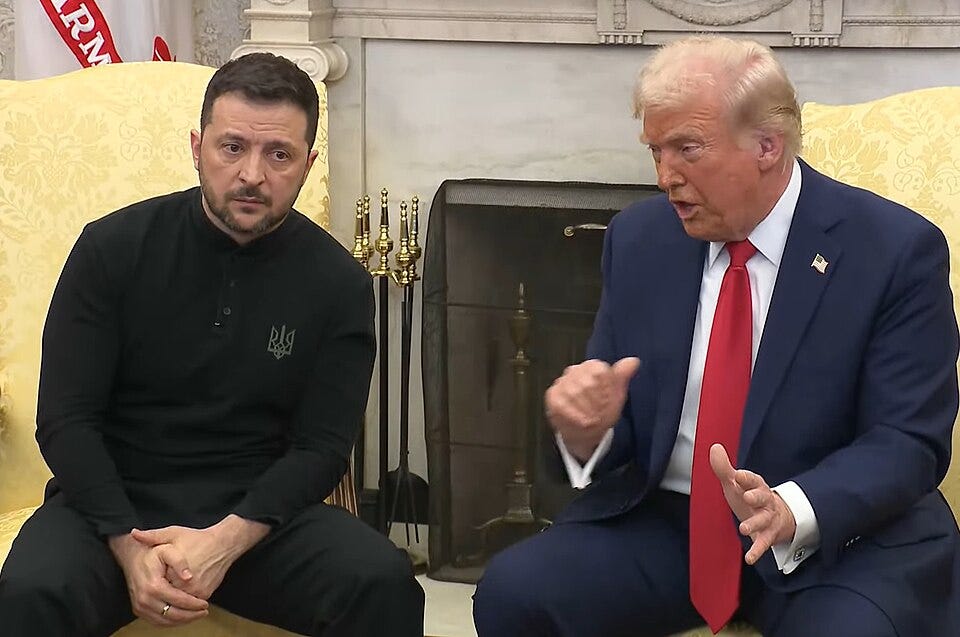Putin is Trump's Ex From Hell
Has the Russian leader cast a spell over the U.S. president?

You know the type. They shower you with praise, and say they were fed up with the last person they dated. Those around your new flame think they might have turned a new leaf. You make plans to meet them, and their ex catches wind of it. The ex calls your new flame, praises them, and suddenly, the romantic weekend you planned isn’t what you had hoped: it seems that the ex has cast a spell over them. The ex promised a rendezvous in a European capital, which finally might make their dreams come true -- and you’re left out in the cold.
This isn’t a story about modern dating, but the ongoing psychodrama between U.S. President Donald Trump, Ukrainian President Volodymyr Zelenskyy, and Russian leader Vladimir Putin. The stakes are higher in Europe’s largest war since World War II, but the dynamic is similar between the three leaders.
After Trump and Zelenskyy met on the sidelines of the U.N. General Assembly meetings in New York in September, Trump posted on social media that he thought Ukraine could win back all of the territory it had lost to Russia. This rosy prediction isn’t shared by most observers of the war, including former Ukrainian Army Chief Valery Zaluzhnyy. In recent weeks, Trump grew increasingly frustrated with Putin, saying that Russia was a “paper tiger.” Western publications ran articles claiming that fortunes had changed and Zelenskyy had finally won over Trump. Earlier this week, the White House and Zelenskyy confirmed a meeting on October 17 in Washington; Kyiv hoped that Trump would finalize a deal sending powerful Tomahawk missiles to Ukraine, a possibility which Trump left open.
However, on October 16, Putin picked up the phone to call Trump and congratulate him on achieving a ceasefire between Israel and Hamas. Trump also took a call from Hungarian Prime Minister Viktor Orban, Putin’s closest ally in the EU. The U.S. president announced before his meeting with Zelenskyy that he and Putin would be meeting in Budapest in “the next two weeks.” About those Tomahawks that Ukraine had so badly wanted? Trump was suddenly cool to the possibility, calling it an “escalation” of the war. In Trump’s thinking, ending the wars in the Middle East and Ukraine would make his ultimate dream come true: the Nobel Peace Prize. (The war will end once Putin knows that he cannot win, which would mean Trump providing Tomahawks — and a consistent flow of arms — to Ukraine. The U.S. has stopped funding Ukraine’s weapons buys under Trump.)
While it’s often said that Trump repeats what the last person to him said, after meeting with Zelenskyy, Trump adopted a more Kremlin-friendly tone. He equivocated about who was responsible for the “killing” in the war in Ukraine, writing on Truth Social while the meeting with Zelenskyy was “interesting” and “cordial,” that he “told him, as I likewise strongly suggested to President Putin, that it is time to stop the killing.” Trump endorsed a cessation of hostilities along the current battle lines -- where Russia holds about a fifth of Ukraine’s territory -- and proclaimed “Let both claim Victory, let History decide!”
This turn of events was entirely predictable: after Trump repeatedly threatened sanctions against Russia this summer, the Kremlin threw Trump a lifeline with the prospect of a one-on-one meeting. The meeting was held on August 15 in Anchorage, Alaska. Putin, who is an international pariah for being under Western sanctions and having an arrest warrant by the International Criminal Court, got a meeting with the U.S. leader while giving up nothing. (The U.S. is not a member of the I.C.C., and while Hungary is in the process of withdrawing from the body, it formally remains a member until 2026.)
In recent weeks, there has been discussion about whether Russia can maintain its military spending for its aggressive war amid a stalling economy and a Ukrainian drone campaign against Russia’s energy industry. But so far, perhaps the most valuable investment the Kremlin has made -- and it doesn’t cost anything -- has been in Trump’s ego.
You are reading Public Sphere, an independent publication which is 100% funded by readers just like you who choose to become paid subscribers. I do not have a paywall today. You can read this site for a week or a month or six months, to see if you like it. If you do—if you think this is a worthwhile place, and you would like to help it survive—I ask that you take a moment to become a paid subscriber yourself.
If you found this post useful, you can use the button below to share it:

